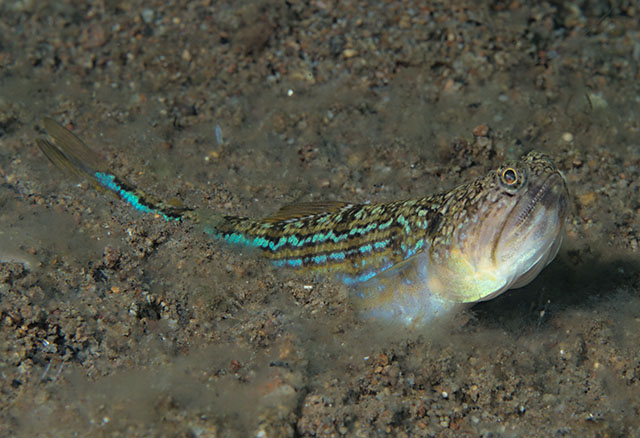| Synodontidae (Lizardfishes), subfamily: Synodontinae |
| 22.8 cm SL (male/unsexed) |
|
reef-associated; brackish; marine; depth range 3 - 388 m |
| Indo-Pacific: African coast of the Indian Ocean and the Red Sea to Hawaii in the
central Pacific Ocean. |
|
Dorsal soft rays (total): 11-14; Anal soft rays: 13-18. This species is distinguished from its congeners by the following characters: snout length (LSn) 40.4-108.5% eye diameter (DE), mean 74.8% (vs. mean 40.1% in T. gauguini and 79.1% in T. trachinus); LSn 15.0-26.0% body depth (DB), mean 21.2 (vs. mean 14.7% in T. gauguini); interorbital width 5.2-12.0%, mean 8.7% LH (vs. mean 5.6% in T. gauguini); DE 11.0-22.6% LH, mean 16.6% (vs. mean 19.6% in T. gauguini and 15.7% in T. myops); length of the last dorsal-fin ray 8.7-11.8% LS, mean 10.1% (vs. mean 10.8% in T. gauguini and 9.4% in T. myops); anal-fin rays 13-18, mode 16 (vs. mode 14 in T. gauguini and 15 in T. myops); pectoral-fin rays 11-13, mode 12 (vs. mode 11 in T. gauguini); predorsal scales 14-18, mode 16 (vs. mode 17 in T. myops). differs further from T. gauguini and T. myops by the deep mitochondrial distances (15.7-19.0 and 15.1-17.8%, respectively) (Ref. 110386). |
| Occurs in estauries and inshore waters to 200 m (Ref. 110386); benthic at 3-388 m (Ref. 58302). Found near shore above 40 m over sandy bottoms of deep outer reef slopes (Ref. 11230). Reported to be common in estuaries (Ref. 11228, 48635). Rest on or more often burrow into substrate, leaving eyes exposed and when disturbed, it may swim a short distance but quickly buries itself again (Ref. 48635). Feed on fishes (Ref. 5213) and small crustaceans (Ref. 36558). |
|
Least Concern (LC); Date assessed: 28 June 2018 Ref. (130435)
|
| harmless |
Source and more info: www.fishbase.org. For personal, classroom, and other internal use only. Not for publication.
